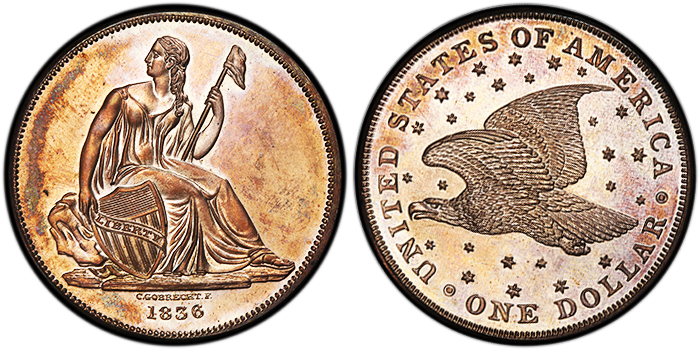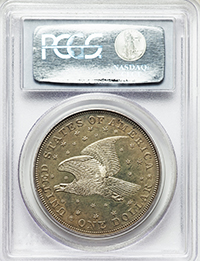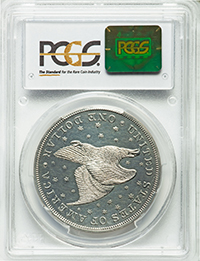Alignment IV - struck circa 1858 -1860, probably by Linderman, et al. (see the emission sequence page for explanation). These pieces first appeared at auction in Ed Cogan's December 1859 sale of the Joseph N.T. Levick collection. They are also noted in Joseph Mickley's "Dates of United States Coins, and Their Degrees of Rarity", the publishing date of which is listed in the numismatic literature as June 1858. However, since the copies seen to date also contain a reprint of Director of the Mint James Ross Snowden's May 1859 notice offering to trade restrikes for Washingtonia for the Cabinet Collection, there is either an earlier printing or the literature is wrong.
|
State A - Line of rust lumps from top of rock up to left, small dash-like lump inside loop of C. No pits between feet A or base of E in STATES.
Obverse: Scattered rust patches in fields, especially noticable in right field opposite leg and as a line of rust lumps from top of rock up to left towards dentils. Few fine polish lines across obverse angled from right to left.
Reverse: Lightly cracked ITED, STATES O, and LLAR (i.e., stress cracks from hardening or initial striking). No pits between feet A or base of E in STATES. A few small scattered rust pits, particularly over O in OF near dentils. Small crack up from right wing towards space between two lowest stars. Faint die line from left wing near tip down towards top of eagle’s head. Small dash-like lump inside loop of C angled from upper left to lower right; this lump is removed by subsequent polishing. The small crack up from right wing is seen on all uses of the Starry Reverse, although it is weakened by polishing on some coins. The small die line from near left wing tip is only seen on this earliest state; it is removed by subsequent polishing. |
Select |
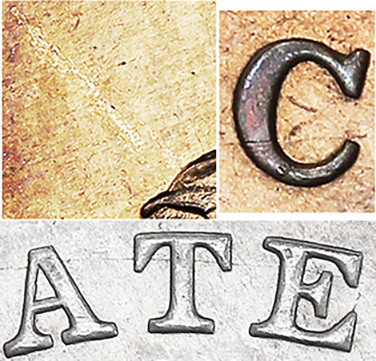 |
| |
State B - Lightly polished removing the rust patches in obverse fields including the line up from rock.
Obverse: Lightly polished removing the rust patches in obverse fields including the line up from rock. A few scattered clash marks in both fields.
Reverse: Lightly polished weakening crack up from right wing and rust pits over O in OF and eliminating die line down from wing near left wing wrist. Small dash-like lump inside loop of C weakened by polishing, now appears as just a dull lumpy line. |
Select |
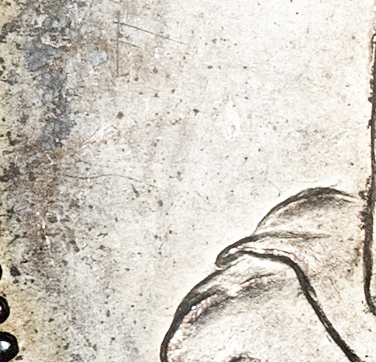 |
| |
Alignment III - struck by Linderman, et al. This alignment may have been suggested by Idler, who Haseltine reportedly claimed could tell the Gobrecht dollars he had struck "at a glance".
|
| |
State C - The emission sequence combined with historical auction prices show that these were struck circa 1859 to 1864. Reverse polished missing lump inside C, but has faint pit between feet of A in STATES and small pit right base of E in STATES.
Obverse: Same as State B.
Reverse: ITED, STATES O, and LLAR cracks a bit stronger. Light polishing eliminates dash-like lump inside loop of C and weakens rust pits over O in OF. Now has a very small lump between feet A in STATES, the beginnings of the “A pit”, and a small pit under the right lower serif of E in STATES.
|
Select |
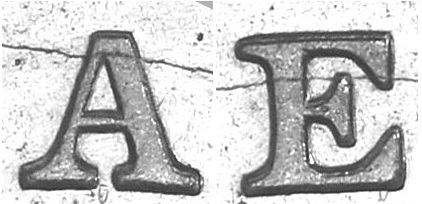 |
| |
State D - The rust in front of the face shows that these pieces were struck circa 1869 just before the copper and mule Cabinet Coins.
Obverse: Rust patch in front of face, scattered rust pits on Liberty and upper half of die. Scattered heavy lines in fields, especially midway in left field opposite upper arm, right field opposite wrist and just above knee opposite junction of elbow and thigh, lower right field opposite F. in name. Lines are quite heavy and appear to be ripples from clashing.
Reverse: ITED, STATES O, and LLAR cracks stronger. Lump between feet A in STATES stronger. Small pit on right base of E in STATES. Now has a die scratch in U from just below inner curve of right upper serif down towards inner left lower curve. Scattered heavy lines in fields, especially around left wing wrist, and below head and body.
|
Select |
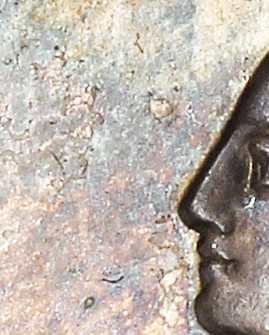 |
| |
State E - Polishing eliminates rust in front of face. Strike weakness at ITED STATES and dentils above. The obverse and reverse die states show that these pieces were struck circa April 1869 just after the Starry Reverse Cabinet Coin restrikes and before those with the Starless Reverse.
Obverse: Highly reflective fields with light polish lines. Polishing eliminates rust in front of face and weakens dentils K9 through K11. State E coins appear to show a light bulging in the left field at K9 to K11, possibly as a result of the aggressive polishing. Drapery at junction hand and shield thinned by polishing. Few strong polish lines and perhaps remnants of clashing in right field.
Reverse: Highly reflective fields with polish lines across most of the die. Polishing nearly eliminates ITED, STATES O and OLLAR cracks and weakens dentils above ITED STA. The polishing has altered the die basin resulting in strike weakness at ITED STATES. Small lump between feet A in STATES and a small pit under the right lower serif of E in STATES. Die scratch in U gone and crack from right foot A in DOLLAR weakened, best visible on the Simpson piece. The Simpson piece also shows a heavy dash-like lump between TA, but this may be a struck-through error as it is only seen on this piece.
|
Select |
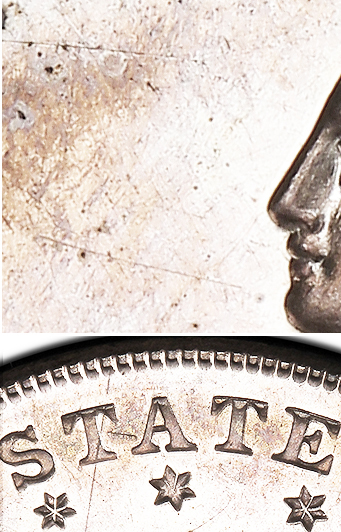 |
